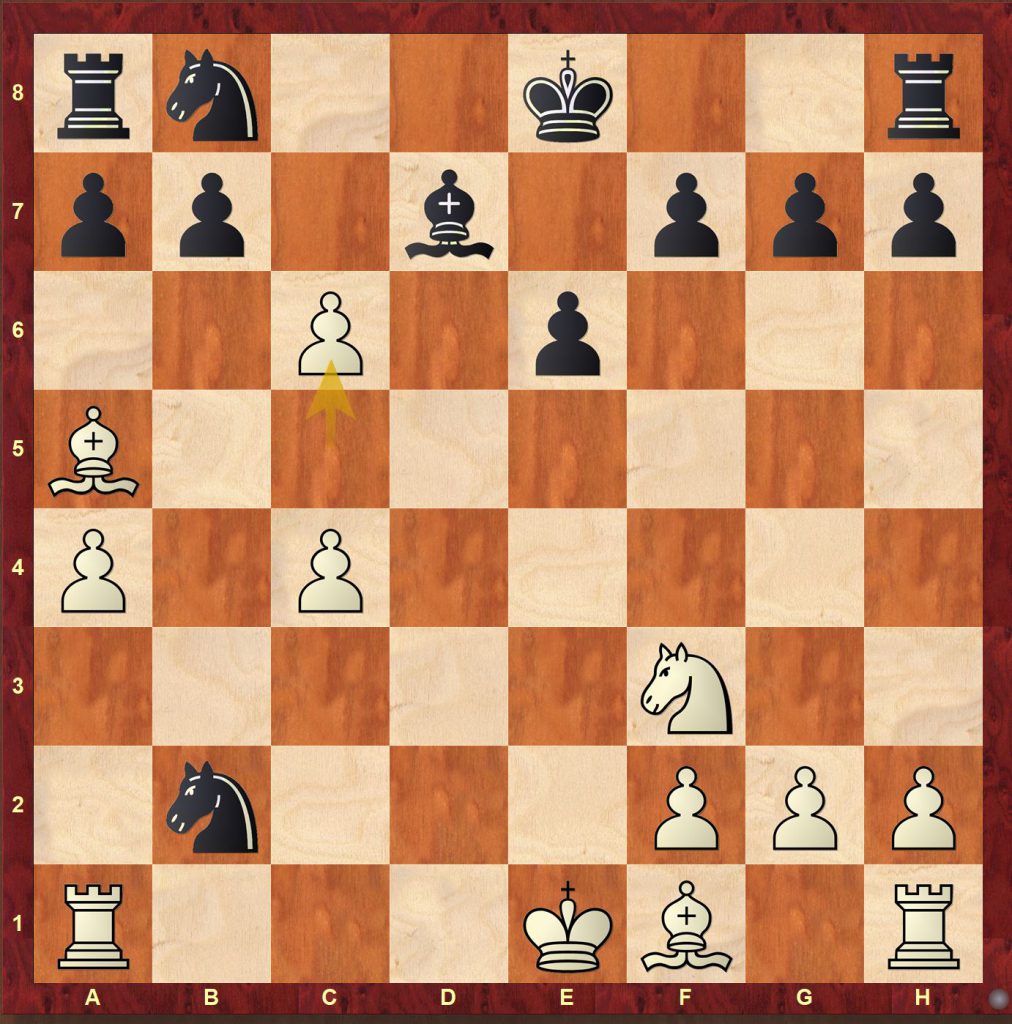Recently, there has been a lot of attention for the games of the great World Champion Emanuel Lasker (World Champion from 1894 to 1921). A couple of years ago, John Nunn wrote an excellent book “John Nunn’s Chess Course” which – although you might not realise it from the title – was a complete chess course based around Lasker’s games. More recently, we saw the wonderful first volume of a planned 3-part biography of Lasker by Forster, Negele and Tischberiek (a must buy!) as well as another fine book of Lasker’s games by Zenon Franco in the Everyman “Move-by-Move” series.
In this last book, I came across the Lasker-Marshall encounter from New York 1924 in which Lasker had White. Although Lasker won (as we are used to: his career score against Marshall was 12 wins to two) the game was a wonderfully creative effort from both sides. It made me take a fresh look at the games these two great players had contested over the years, and I found much that was interesting to analyse. This inspired me to start a series of blog articles based around their encounters. We start off with the very first game between these players, played in Paris in 1900. Marshall won this sharp fight. How could he know that he would have to wait 40 years to score his second victory?
A video of this article is also available at https://www.youtube.com/watch?v=FjFlrxfy4WE As always, a playable version of this game is available at http://cloudserver.chessbase.com/MTIyMTYx/replay.html
Marshall,Frank James – Lasker,Emanuel [D50]
Paris 28.05.1900
[https://matthewsadler.me.uk]
1.d4 d5 2.c4 e6 3.Nc3 Nf6
[3…c6 4.e4 dxe4 5.Nxe4 Bb4+ 6.Nc3 was Marshall’s first go at this line, before he developed the sharp pawn sacrifice with 6.Bd2 that bears his name and is still a hot topic of theoretical discussion.
6.Bd2 Qxd4 7.Bxb4 Qxe4+ 8.Be2 Na6 (8…Nd7 9.Nf3 c5 10.Bc3 Ngf6 11.Qd6 Qc6 12.Qg3 0–0 13.Rd1 Nh5 14.Qh4 g6 15.Rxd7 Qxd7 16.g4 Powerful chess! Strangely enough, this game doesn’t even make it into Marshall’s Best Games! 16…Qd8 17.gxh5 Qxh4 18.Nxh4 e5 19.hxg6 hxg6 20.Rg1 Re8 21.Nf3 f6 22.Rxg6+ Kf7 23.Rg3 Bd7 24.Nd2 Rh8 25.Ne4 b6 26.Rf3 f5 27.Bxe5 Rh4 28.Nd6+ 1–0 (28) Marshall,F-Schlechter,C Monte Carlo 1902) 9.Bc3 (9.Ba5 forcing a weakening of Black’s pawn structure with 9…b6 before returning to c3 is the modern treatment of this line.) 9…Ne7 10.Nf3 0–0 11.0–0 f6 12.Re1 e5 13.Bd3 Qg4 14.Re4 Qe6 15.b4 Qf7 16.Nh4 g5 17.Nf3 Bf5 18.Re3 Rad8 went somewhat less well for White although Marshall managed to trun the game around and win in 65 moves. 1–0 (65) Marshall,F-Schrader,E Saint Louis 1904)
6.Nc3 c5 7.a3 Ba5 8.Nf3 cxd4 9.Qxd4 Qxd4 10.Nxd4 Bxc3+ 11.bxc3 a6 12.Bf4 f6 13.Bd6 e5 14.Nc2 Ne7 15.Ne3 Nbc6 16.Nd5 Nxd5 17.cxd5 Ne7 18.c4 Bf5 19.Be2 Kd7 20.Bb4 a5 21.Bxe7 Kxe7 22.0–0 b6 23.f4 exf4 24.Rxf4 Bg6 25.Ra2 Kd6 26.Rb2 Rab8 27.Rf3 Bh5 28.Rfb3 Bxe2 29.Rxe2 Kc5 30.Re4 Rhd8 31.Rb5+ Kd6 32.Re6+ Kc7 33.Rc6+ 1–0 (33) Marshall,F-Teichmann,R London 1902]
4.Bg5 c6 5.e4
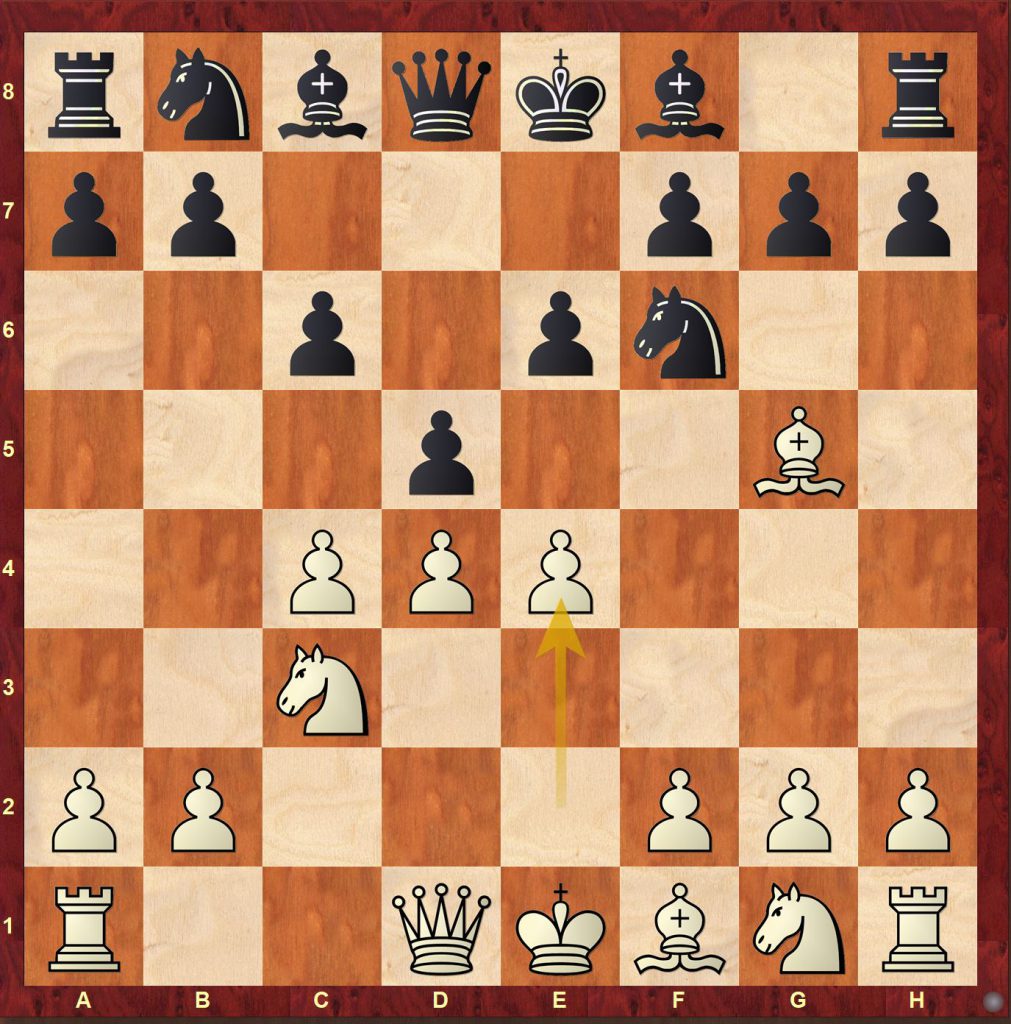
[A little-played move, leading to a position reminiscent of the variation 1.d4 d5 2.c4 e6 3.Nc3 c6 4.e4 dxe4 5.Nxe4 Bb4+ 6.Nc3 which Marshall also played. Teichmann was not too impressed with his idea stating in his annotations for the British Chess Magazine that “it is doubtful whether this early advance of the King’s Pawn to the fourth is good; and I think that the continuation adopted by Dr Lasker ought to have given him a good game”. Marshall confessed a fondness for this move in “Marshall’s Best Games of Chess” but “eventually I discarded it as it cannot lead to a permanent initiative”.]
5…dxe4 6.Nxe4 Bb4+ 7.Nc3 c5 8.a3 Bxc3+ 9.bxc3 Qa5 10.Bd2 Ne4 11.Nf3 [A novelty from Marshall!]
[11.Qc2 was a little slow and gave Black a good game after 11…Nxd2 12.Qxd2 0–0 13.Nf3 Rd8 14.Be2 Nc6 15.Rd1 Qxa3 16.0–0 ½–½ (86) Metger,J-Charousek,R Berlin 1897]
11…Nxc3 [Very risky from Lasker.]
[11…0–0 12.Bd3 Nxd2 13.Qxd2 Nc6 was best with a balanced and interesting game.]
12.dxc5 [12.Qb3 cxd4 13.Nxd4 Qe5+ is Black’s main defensive point although my engine still prefers White after 14.Be3 Ne4 15.Qb5+ Qxb5 16.Nxb5 Na6 17.f3 Nf6 18.Nxa7 Marshall’s choice is the most ambitious attempt to punish Black’s opening play.]
12…Nxd1 13.Bxa5 Nb2 14.a4
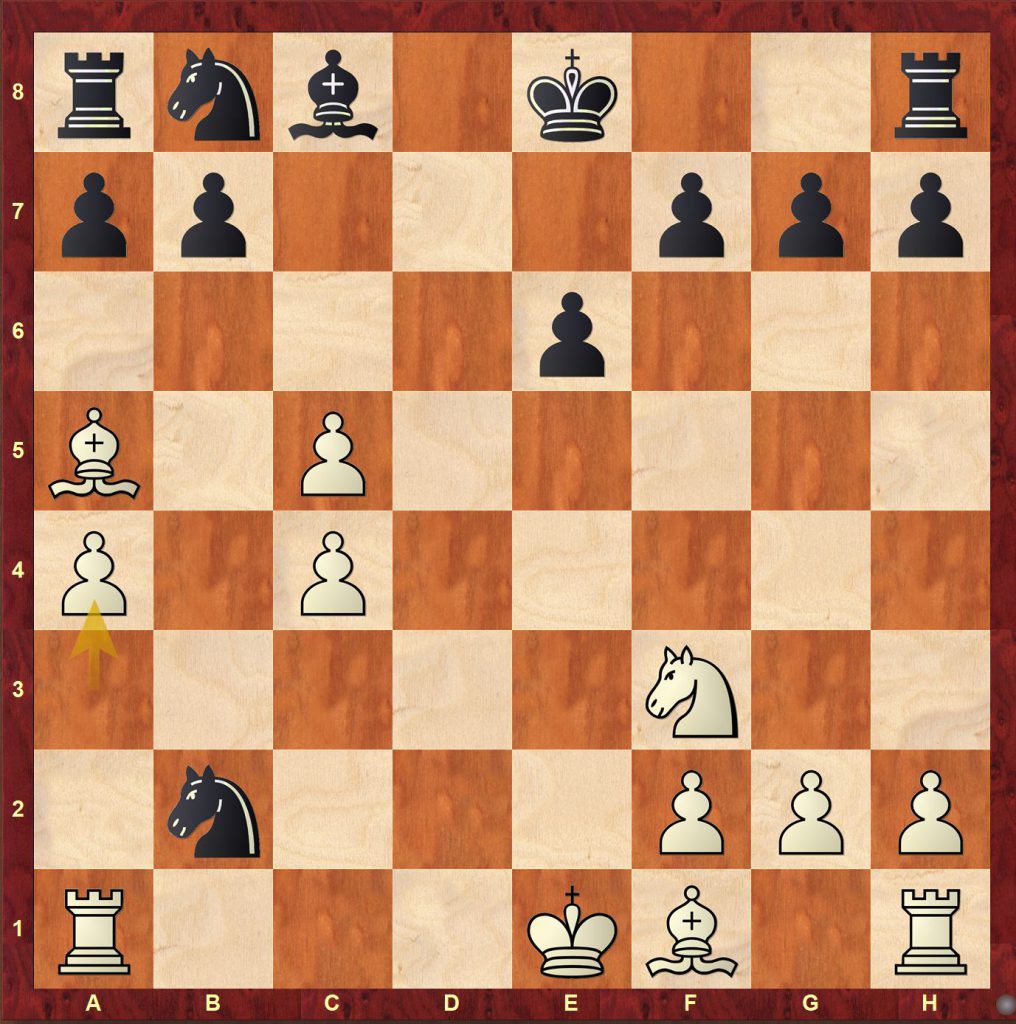
[The sharpest attempt, blocking the retreat path of the knight on b2 back to a4 and preparing Bc3 or Ra2 winning the knight.]
14…Bd7 15.c6
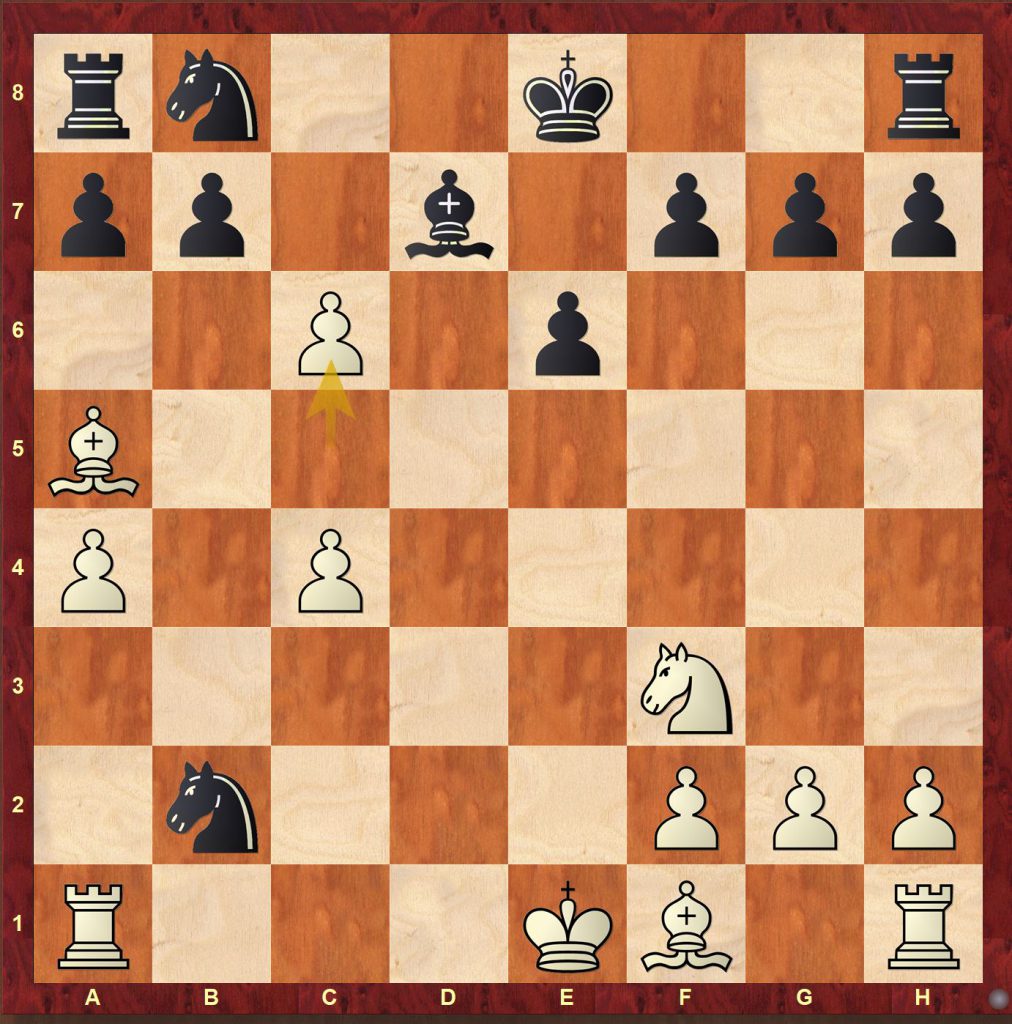
[A neat intermezzo which is the only way to set Black any problems. Black must capture on c6 with the bishop to keep up the threat of …Nxa4, but this removes his ability to meet Ne5 or Nd4 with …Nc6.]
[15.Ne5 Nc6 16.Nxd7 Nxa5 is Black’s key resource when 17.Ne5 Rc8 ensures the survival of the knight on b2]
15…Bxc6 16.Ne5 [Tricky but not the most accurate I thought, and my engine agrees with me.]
[16.Nd4 is a cleverer way to play, avoiding the tempo with …Nd7.
16…b6 17.Bd2 (17.Bb4 is the engine suggestion and may be even a little stronger despite the possibility of tempo gains on the bishop with …Na6 or …Nc6 which put me off, as Black is now no longer able to castle kingside.) 17…Be4 18.Nb5 is the key idea, threatening both Nc7+ and Nd6+ (18.Ra3 was my first thought but it isn’t that good! 18…Nc6 19.Bc3 Rd8 (19…Nd1 was an alternative thought of mine, but I just felt I was sending my knight into even more perilous adventures after 20.Nxc6 Nxc3 21.Ne5 Nb1) 20.Nxc6 Rd1+ 21.Ke2 Bd3+ 22.Kf3 Nxc4 23.Ra1 Unfortunately I made a tactical error here missing White’s cunning point (23.Bxd3 Rxd3+ 24.Ke2 Rd6 25.Nxa7 The tactical reason why Black plays 19…Rd8 rather than 19…0–0–0. Nxa7 is not check! 25…Nxa3 26.Bb4 Rd4 27.Bxa3 Rxa4 28.Nb5 Kd7 was my line with a pleasant position for Black.) 23…Nd2+ (23…Rxa1 24.Bxa1 Bxf1 was my idea, but there is a sting in the tail! 25.Bc3 (25.Rxf1 Nd2+ looked fine for Black.) 25…Bd3 26.Rd1 is terminal as 26…Bg6 allows 27.Rd8#) 24.Bxd2 Rxa1 25.Bxd3 Rxh1 26.Nxa7 f6 is a crazy endgame, but probably about balanced as Black should be able to give up a rook for minor piece and a-pawn.) 18…Kd7 19.Bc3 a6 20.Bxg7 Rg8 21.Bxb2 axb5 22.f3 Bg6 23.axb5 is a clear pawn for White.
16…Be4 17.Nb5
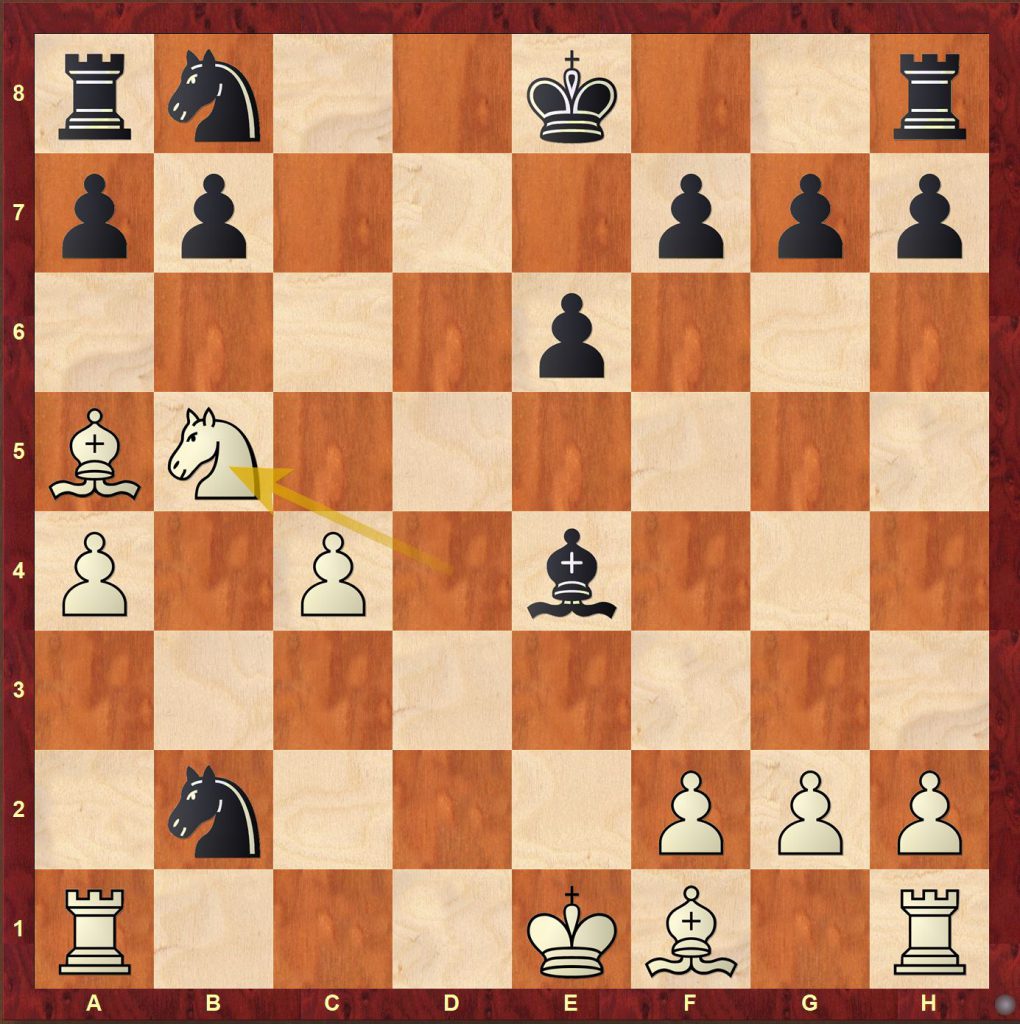
17…0–0 (17…Nc6 18.Bc3 Nd3+ 19.Bxd3 Bxd3 20.Nc7+ Ke7 21.Nxa8 Rxa8 22.c5 was my main line with a pleasant advantage for White, though there is still some work to do to convert it into a win.) 18.Bc3 Nd3+ 19.Bxd3 Bxd3 20.Nc7 Na6 21.Nxa8 Rxa8 22.Rc1 f6 is the engine main line and may be a cleverer way to play this line, although White has a very pleasant advantage in both cases,]
16…Be4
[16…Nd7 Pointed out by Teichmann and Marshall 17.Nxc6 bxc6 manages to keep the knight safe by forcing the opening of the b-file. The crux is a rather undeserved tactic! 18.Bc3 (18.Kd2 Nc5 19.Kc2 Nbxa4 20.Be2 0–0 21.Ra2 gives White sufficient compensation for the two pawns but no more than that.) 18…Rb8 19.Bxg7 (19.Ra2 Nxc4 20.Bxc4 Rb1+ wins! That feels unfair!) 19…Rg8 20.Bd4 The position is still quite complicated but Black’s lead in development and White’s queenside pawn weaknesses should give Black safe passage to equality. Marshall gives a follow-up which doesn’t entirely meet with engine approval! 20…e5 21.Bc3 Nc5 22.a5 f6 and as Marshall states “the position of the advanced knight would then be safe but awkward”;
16…b6 17.Bd2 followed by Bc1 or Ra2 wins]
17.Bc3 [A mistake which gives Black a way of escaping which I found, but had real trouble believing!]
[17.Ra2 is the best way to attack the knight on b2. 17…f6 18.f3 Bf5 19.g4 is the key idea as the …Bc2 idea in the game fails simply to Rxb2.;
17.f3 f6 is given by Marshall as the move order played, but that is hard to believe: simply 18.fxe4 fxe5 19.Bc3 wins easily]
17…f6 18.f3
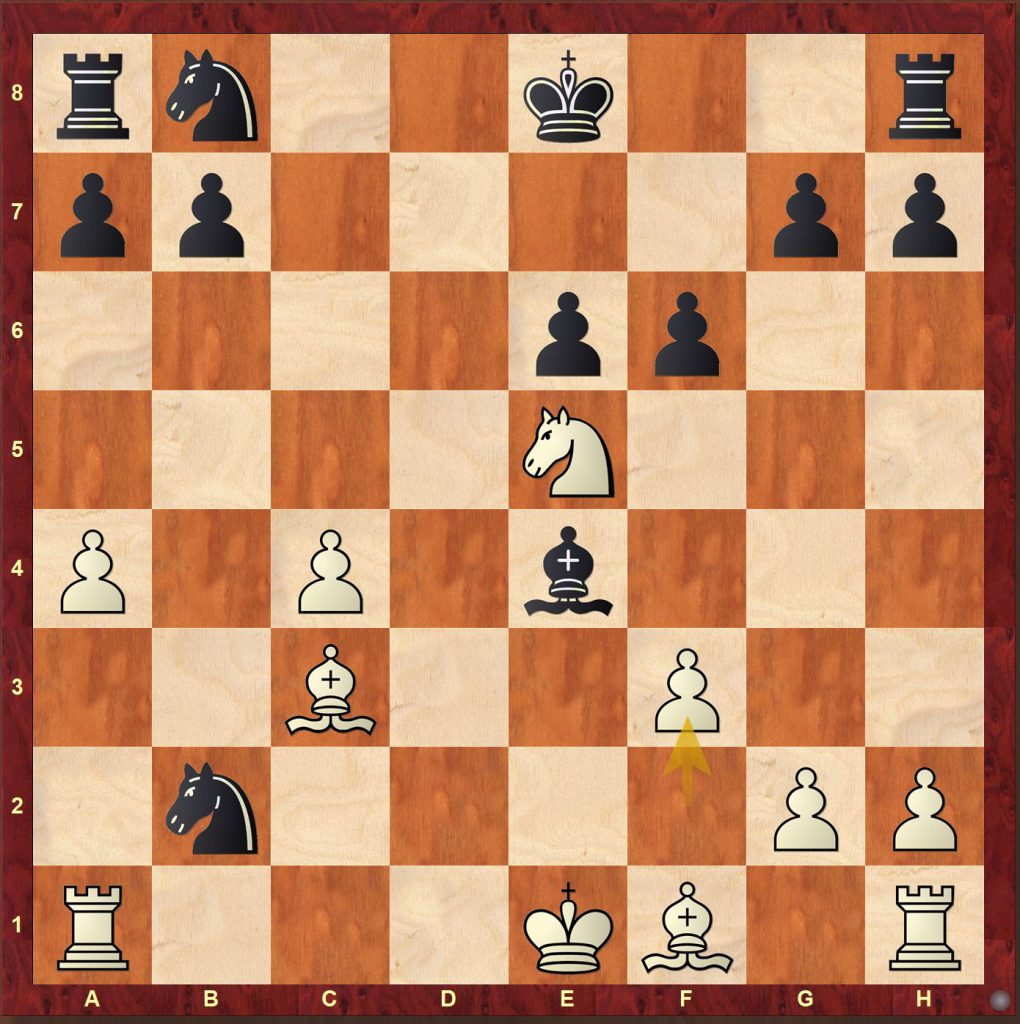
18…Bc2 [18…Bf5 is the key idea to force White to take away the g4 square from his own knight after which the knight on e5 has no good retreat square! 19.g4 Bc2 20.Kd2 Nd1 Amazing but true! 21.Kxc2 Ne3+ 22.Kd3 (22.Kb3 fxe5 (22…Nxf1 23.Nd3 Ne3 24.Ra2 shows a disadvantage to forcing g4: the knight is trapped on e3!) ) 22…Nxf1 was my variation, when the knight on f1 is trapped…but then so is the knight on e5! White is still better of course, but it’s better than lost!]
19.Kd2 Nxa4 20.Kxc2 Nxc3 21.Nd3 Nd5 22.cxd5 exd5 23.Nc5 b6 24.Bb5+ Kf7 25.Na4 Nc6 26.Nc3 Rhc8 27.Rhd1 Ne7 28.Kb2 Rc7 29.Bd3 [29.Nxd5 Rc5 is given by Marshall but simply 30.Nc3 is fine for White.]
29…a5 30.Na4 Rc6 31.Rac1 Rb8 32.Rxc6 Nxc6 33.Rc1 Ne5 34.Rc7+ Ke6 35.Bb5 g5 36.Ra7 d4 37.Ra6 Kd5 38.Kc2 Rb7 39.Ra8 Nc6 40.Kd2 Nb4 41.Rd8+ Ke5 42.Nb2 Rc7 43.Nc4+ Kf5 44.Rxd4 Rc5 45.Be8 Rd5 46.Ne3+ Ke5 47.Nxd5 Kxd4 48.Nxb4 axb4 49.Bf7 f5 50.Bg8 h5 51.Bf7 h4 52.h3 b5 53.Be8 Kc4 54.Bd7 b3 55.Bxf5 Kb4 56.Bd3 b2 57.Kc2 Ka3 58.Kb1 1–0



